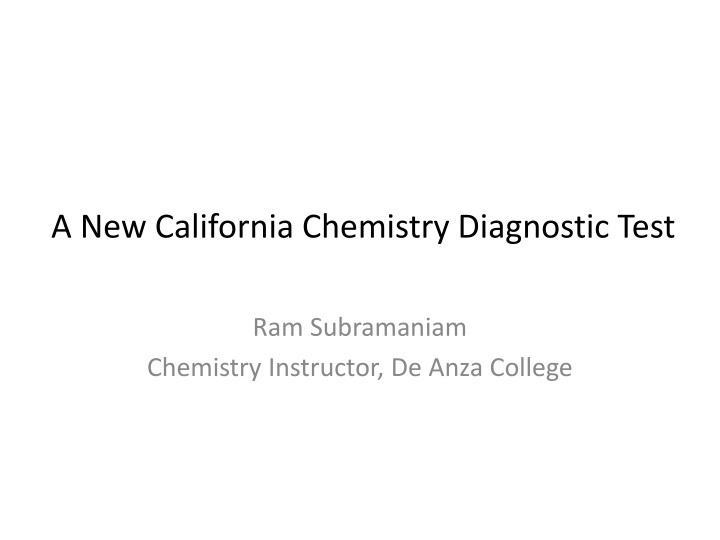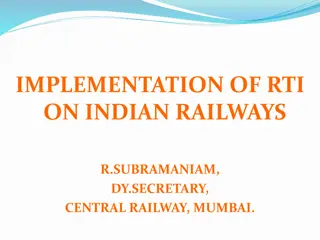
California Chemistry Diagnostic Test Overview
"Explore the history, objectives, composition, and usage of the California Chemistry Diagnostic Test designed by Ram Subramaniam and a team of educators. Learn about its role in evaluating students' readiness for General Chemistry and guiding placement decisions."
Download Presentation

Please find below an Image/Link to download the presentation.
The content on the website is provided AS IS for your information and personal use only. It may not be sold, licensed, or shared on other websites without obtaining consent from the author. If you encounter any issues during the download, it is possible that the publisher has removed the file from their server.
You are allowed to download the files provided on this website for personal or commercial use, subject to the condition that they are used lawfully. All files are the property of their respective owners.
The content on the website is provided AS IS for your information and personal use only. It may not be sold, licensed, or shared on other websites without obtaining consent from the author.
E N D
Presentation Transcript
A New California Chemistry Diagnostic Test Ram Subramaniam Chemistry Instructor, De Anza College
The Team Member Affiliation Arlene Russell UCLA Barbara Gonzalez CSU Fullerton Jack Eichler UC Riverside Ozcan Gulacar UC Davis James Rudd CSU LA Allegra Eroy-Reveles SFSU Sally Ghizzoni Santa Brabara City College Rebecca Eikey College of the Canyons Ram Subramaniam De Anza College Cristina Robitu Kennedy AUHSD Brady Billhartz Valencia PYLUSD Gema Suarez Anaheim AUHDS Chanda Strom San Gabrielino High School
History of the Test 1985: A survey of 10 different tests indicated wide variations in topics and difficulties in pre-testing A committee of UC, CSU, and Community College faculty was formed to draft a new test The committee found the following to be most widely taught topics: Compounds and Elements States of Matter Reactions of Matter Structure of Matter Periodic properties Solutions Thermodynamics and Kinetics Lab skills In addition, the test also included Mathematics questions
How is the current version being used? Diagnostic: are students prepared for General Chemistry? Test score is a good predictor of the grade in General Chemistry Test identifies areas of deficiency and strength Placement: which General Chemistry class should the student be placed in?
Objectives of the current team Develop a new diagnostic test Incorporate questions not previously used Include same numbers of questions within each topic as in previous test The test will be field tested to determine its validity, reliability, and predictive ability Distribute the test through the ACS Exam Institute
Composition of the test Topic Number of questions Compounds and Elements 5 States of Matter 3 Reactions of Matter 5 Structure of Matter 6 Periodic Properties 5 Solutions 7 Chemical Dynamics 2 Laboratory Skills 4 Mathematics 7
Format of the test There are 44 questions in multiple choice format Each question has four possible answers with one correct response and three distracters The test should be answered in one hour Students will be provided with: Periodic table Simple conversion factors Abbreviations and symbols Grade on the test = number of correct responses
Types of Questions What is the molarity of a solution prepared by dissolving 5.85 grams of sodium chloride in enough water to prepare a solution whose volume is 250.0 mL? A. 0.0234 M B. 0.400 M (ANSWER) C. 2.50 M D. 23.4 M Given that a is inversely proportional to b , which of the following statements is true? A. When a is doubled in value, b also doubles in value B. When a is doubled in value, b becomes half its original value C. When a is doubled in value, b becomes four times its original value D. When a is doubled in value, b remains unchanged
Status of the test All the test questions have been written, edited, and approved by the team The test is being formatted for ACS standards The test will be field tested for its ability to predict student success in General Chemistry, in the spring of this year The final version of the test is expected to be available for distribution after January of 2017 (subject to revisions and edits)
Next steps for the team A variety of field tests at community colleges, CSU, and UC have been planned for the spring term of 2016 The data from the field test will be analyzed and adjustments will be made to the test if necessary Faculty interested in supporting the CCC approval process for the test s use as a diagnostic at their institution should contact Jack Eichler
Contact Information Jack F. Eichler, PhD, UCR Department of Chemistry, 501 Big Springs Rd, Chemical Sciences 220, Riverside, CA 92521, 951-827-3794 jack.eichler@ucr.edu Barbara L. Gonzalez, Ph.D., California State University Fullerton, Department of Chemistry and Biochemistry, 800 N. State College Blvd., Fullerton, CA 92834-6866, 657 278-3870, bgonzalez@fullerton.edu Arlene A. Russell PhD, University of California, Los Angeles, 1037A Young Hall, Los Angeles, CA 90095-1569, 310-825-7570, russell@chem.ucla.edu Ram Subramaniam, Ph.D., Chemistry Department, De Anza College, 21250 Stevens Creek Blvd., Cupertino, CA 95014, 408-864-8517, subramaniamram@fhda.edu

